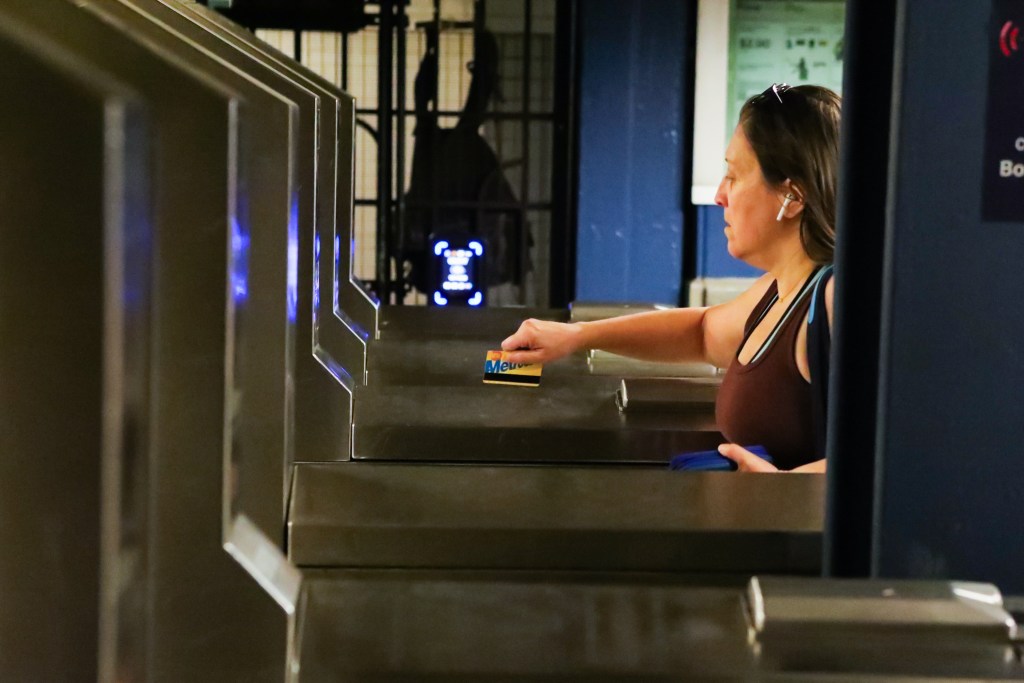These New Yorkers are among the last of a vanishing breed who swear by the swipe or the dip of a MetroCard.
With the MTA in a transition to full OMNY tap-and-go technology, transit officials said Monday that one-third of last month’s 146 million subway and bus riders remain MetroCard loyalists — even with sales of the yellow and blue fare cards set to end Dec. 31.
“It’s not that we can’t accept change,” Margoth Moreno, 60, told THE CITY after swiping her MetroCard Tuesday at the 96th Street station along the 1, 2 and 3 lines. “It’s just that we don’t want to make the change — like me.”
Even as the holdouts realize the MetroCard’s days are numbered, they hold on to the plastic fare cards that were initially introduced in January 1994 at two Lower Manhattan stations as the eventual successor to subway tokens, which took their final turnstile drops in May 2004.
“I’m just not where I need to be yet in terms of feeling comfortable with OMNY,” said Juan Mendez, 49, who swiped his way past a turnstile at Times Square-42nd Street. “The MetroCard is a hard habit to break.”
Transit officials acknowledged as much during a series of presentations about the MTA’s lengthy transition to tap-and-go fare payments, which can be made through mobile devices, bank cards or physical OMNY cards sold in station vending machines and at some stores.
“We hear from some of our customers, a small share, that having a physical fare media card is important to them,” said Jessie Lazarus, MTA deputy chief of commercial ventures. “And so these customers are going to keep using a MetroCard until an OMNY machine reaches their station and we pull the MetroCard machine out.”
That process hit a milestone over the weekend in Queens, when the Jackson Heights-Roosevelt Avenue/74th Street, Court Square and 21st Street-Queensbridge stations became the first to be stripped entirely of MetroCard vending machines removed in favor of machines that allow riders to buy or refill OMNY cards.
A rider uses a MetroCard machine next to an OMNY one at the Brooklyn Bridge station, April 30, 2025. Credit: Ben Fractenberg/THE CITY
More than 670 OMNY vending machines are presently installed in 325 stations, according to the MTA, which is aiming to have 40% fewer machines with the new system than it does with MetroCards, given the increased number of ways to pay for rides.
“We’re teaching customers how to buy and reload OMNY cards at these vending machines,” Lazarus said. “But we’re also informing them that with OMNY cards, now they can reload their cards online or at one of our local business retail partners when picking up a prescription at the pharmacy or buying milk at the bodega.”
The MTA has said it expects to save at least $20 million a year in vending machine repairs and MetroCard production and distribution.
The Last Days
At the Jackson Heights hub on Tuesday morning, customer service workers guided confused riders trying to acclimate to using OMNY for the first time or buying tap-and-go cards from new-look vending machines.
Still, skeptics abound among the devoted MetroCard users.
“I would rather have the MetroCard than the OMNY because I tried it before and I had a lot of problems,” said Roberto Gonzalez, 70, after swiping into the station with a MetroCard.
Transit officials on Monday highlighted OMNY’s increasing usage, pointing out how tap-and-go usage in the subway hit 70% in March — up from 43% two years earlier.
Similarly, the share of tap-and-go fare payments on buses was at 59% in March, a 33-point increase from April 2023.
“They do this because it’s easy and it saves them time and it saves them money,” Lazarus said. “They’re not waiting at a vending machine line or worrying about how many trips to prepay on a MetroCard.”
Luis Ortiz is among the third of New York City Transit riders who remains a MetroCard loyalist, April 29, 2025. Credit: Jose Martinez/THE CITY
According to the MTA, 85% of riders who pay the full $2.90 fare use tap-and-go, compared with 56% of those who are paying reduced fares. A year ago, the MTA said those figures were at 75% and 7%.
MTA officials said that points to benefits that accompany OMNY, such as the fare-cap measure that lets riders travel for free once they use the same device or fare card to pay for 12 rides within the course of any seven-day period.
“This customer base has just been buying Metrocards and paying $2.90 every time, no matter how frequently they’re traveling,” Lazarus said. “But now, just by virtue of switching to tap and go, they’ll never spend more than $34 in seven days, no pre-planning required.”
The pay-as-you-go method over seven days contrasts with the seven-day unlimited ride MetroCard, which costs $34 no matter how many times a rider uses it.
Nevertheless, some holdouts told THE CITY they will ride with the MetroCard until they no longer can.
“I used the token until the very last day,” Luis Ortiz, 62, said at the 96th Street stop, adding that has never used OMNY. “I’ll probably stick with the MetroCard until the last day, too.”
Our nonprofit newsroom relies on donations from readers to sustain our local reporting and keep it free for all New Yorkers. Donate to THE CITY today.
The post MetroCard Holdouts Cling to Slivers of Plastic Despite Tap-and-Go OMNY-presence appeared first on THE CITY – NYC News.

